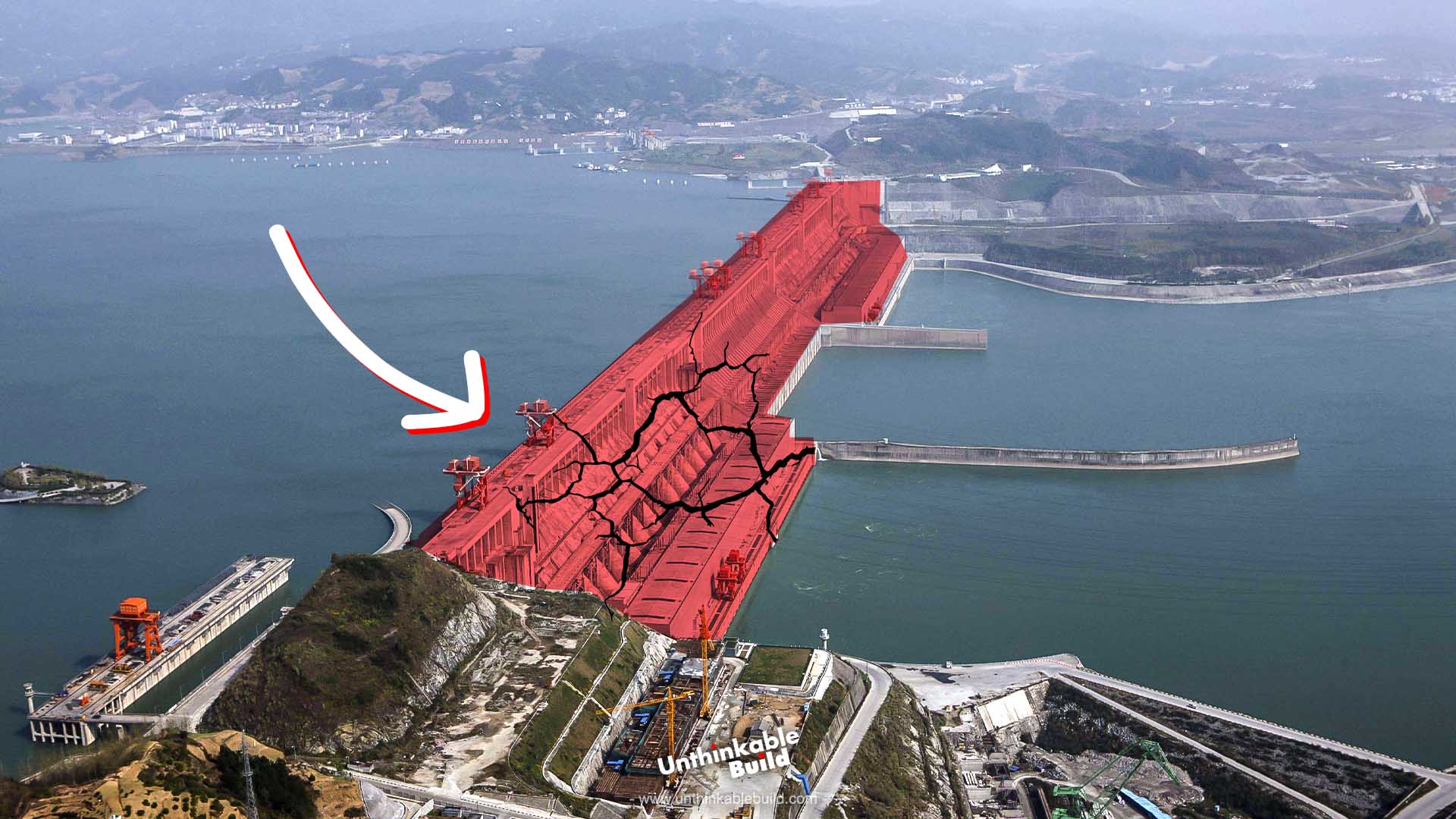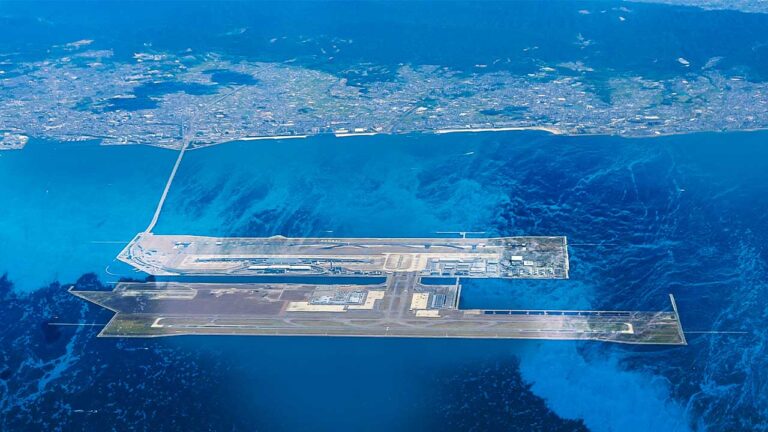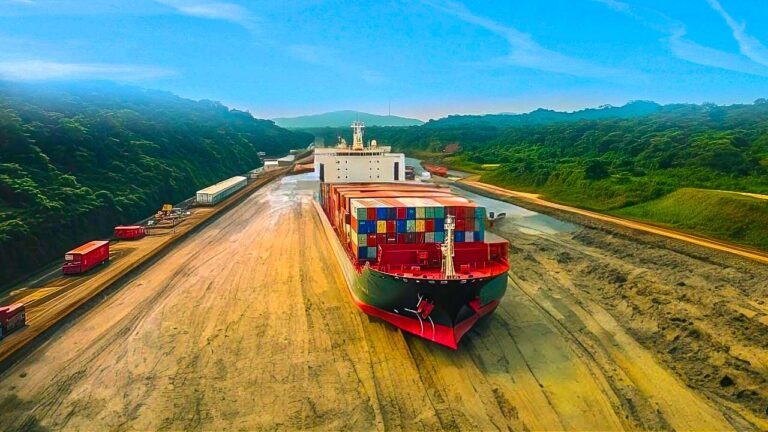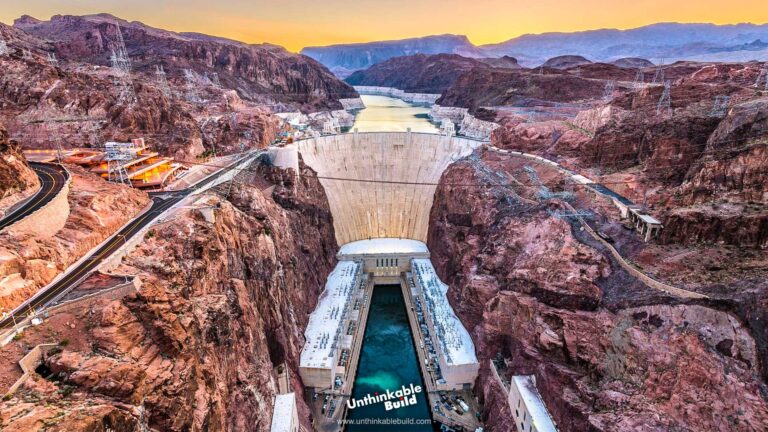What If World’s Biggest Three Gorges Dam Failed?
Energy is the cornerstone of industrial growth, and for any country aiming to compete globally, it is an absolute necessity. China, in its quest to excel on the global stage, has also put immense effort into leading the energy sector, with a particular focus on hydroelectric power. This drive stems from a need to power its thriving industrial production and keep up with a fast-growing population. One of these initiatives is the Three Gorges Dam, world’s largest hydropower facility that was completed in 2006 on The Yangtze River in China’s central Hubei province.
The Three Gorges Dam stands as a testament to China’s ambition to manage its natural challenges and drive progress, even as it reflects the significant human and environmental costs of such a grand endeavor.
Unfortunately, this mega structure has become a source of global concern, largely because climate change is causing more intense flooding in China each year. Experts worry about what could happen if something were to go wrong. If the Three Gorges Dam were to suffer a major failure, the consequences could be catastrophic, not just for the immediate area but for much of the cities downstream, given how crucial it is for energy and flood control.
Can China take the necessary steps to minimize these risks and safeguard the vital structure of Three Gorges Dam? And just how likely is it that the dam could sustain serious damages? These questions are becoming more pressing as the dam faces growing environmental pressures, making it clear that action is needed to ensure its long-term safety.
China, being the world’s second-largest economic powerhouse, has gone all out to secure its energy needs by building an astounding 94,000 dams so far. These massive structures are not just about harnessing energy, but also about cementing China’s position in the region and driving its rapid industrial progress. But here’s the worrying part—many of these dams are beginning to falter before they can fully deliver the energy they were meant to provide. This situation not only puts China’s energy security at risk but also raises serious concerns about the future of its infrastructure and the sustainability of its ambitious growth plans.
The massive structure of world’s largest Three Gorges Dam, was built at a staggering cost of $31.765 billion. It was primarily designed not just to prevent floods and generate power but also to improve river navigation—a true symbol of China’s engineering might. But despite its impressive scale and purpose, the dam is facing its share of challenges.
The Yangtze River, extending a remarkable 6,300 km, is not only the longest river in Eurasia but also the third longest in the world. It’s a river often plagued by devastating floods that have shaped the lives of countless people along its banks. Despite these challenges, the Yangtze is a lifeline for China’s agriculture, supporting nearly half of the country’s food needs through its fertile basin.
To tackle the river’s flood risks and harness its power, China undertook one of its most ambitious projects: the Three Gorges Dam. Settled in Hubei Province, this enormous dam, which started construction in 1994, is the largest hydroelectric facility in the world, stretching 2.3 km across the river. The scale of this project is nothing short of extraordinary, involving the relocation of about 1.4 million people to clear the necessary land, which is an immense sacrifice for those displaced from their homes and communities.
Also Read: Inside Frankfurt’s $4BN Airport Terminal 3 Expansion
Three Gorges dam was designed to address several issues, but its primary goal was to control the severe flooding that has historically impacted the region. Additionally, it was built to generate substantial hydroelectric power, helping to meet China’s growing energy demands especially for its industry. Improving navigation on the Yangtze was another key objective that makes it easier to transport goods and resources along this vital waterway.
Owned by the China Three Gorges Corporation, this is the largest hydroelectric dam in the world. Its massive 1.4-mile-long concrete gravity structure features 34 turbo generators and a power plant with an installed capacity of 22.5 Giga Watt. It also boasts a remarkable 1,584-foot-long spillway, with powerhouses situated on both its left and right sides. Since becoming operational in 2003, the Three Gorges Dam has been a vital source of electricity for Central and Eastern China, along with Guangdong Province in the south.
Building the Three Gorges Dam was no small feat, and the engineers faced several significant challenges along the way. The site where the dam was constructed had complex geological conditions, including soft rock layers and seismic activity and since the Dam’s construction landslides have become frequent in the area resulting in millions of dollars in Damages. To overcome these issues, the team had to use deep foundations, grouting, and rock anchors to stabilize the structure and ensure its durability.
The construction also had a considerable environmental impact and affected local ecosystems, wildlife, and water quality. To address these concerns, efforts were made to mitigate the damage by installing fish ladders, creating wildlife corridors, and closely monitoring water quality.
Sediment buildup was another challenge for engineers. The Yangtze River carries a lot of sediment, which the dam’s reservoir traps. This can lead to downstream erosion problems. This problem was tackled by designing sluice gates to release sediment periodically, keeping the river flowing smoothly.
The Three Gorges Dam is a key player in China’s strategy to reduce greenhouse gas emissions. By providing a significant amount of clean, renewable electricity and reducing the reliance on fossil fuels like coal, natural gas and oil, it helps to address the challenges of climate change and supports a transition toward more sustainable energy sources.
The Three Gorges Dam has made a significant contribution to reducing greenhouse gas emissions. The dam generates renewable and sustainable electricity by harnessing the power of the Yangtze River. This shift to hydropower has lessen the dependence on conventional thermal energy sources, which are major contributors to carbon dioxide emissions. By providing a cleaner alternative, the Three Gorges Dam plays a crucial role in lowering the overall carbon footprint of China’s energy sector.
The impact of the dam extends notably to coal consumption. To generate the same amount of electricity as the Three Gorges Dam, Chinese coal-fired power plants would need to burn approximately 90 million tons of coal. This reduction in coal usage leads to successfully eliminate the emission of 86.7 million tons of Carbon Dioxide, 20,600 tons of Sulfur Dioxide and 19,000 tons of Nitrogen Oxide, showcasing the dam’s effectiveness in curbing one of the most pressing sources of greenhouse gases. Additionally, the improved navigation capacity around the dam area enhances energy efficiency and further reduces emissions by facilitating more efficient transportation of goods and resources.
While it’s true that hydropower reservoirs can release methane, a greenhouse gas, the overall environmental impact of the Three Gorges Dam remains positive. The methane emissions from the reservoir are outweighed by the substantial reduction in Carbon Dioxide emissions from displacing fossil fuel-based power generation. Efforts are also made to mitigate these emissions through various environmental management practices.
Managing the project’s enormous budget and tight timeline was an ongoing challenge, but the successful completion of the Three Gorges Dam stands as a testament to human ingenuity and perseverance in the face of adversity.
The Three Gorges Dam boasts a remarkable ship lift, inspired by the principles of the ancient Greek mathematician Archimedes, who discovered that the weight of a buoyant object is equal to the weight of the water it displaces.
The ship lift at the Three Gorges Dam is a modern marvel, designed to handle ships weighing up to 3,000 metric tons. Following the principle, a huge water-tight chamber open from the bottom, raises and lowers boats. This chamber is supported by 256 ropes linked to counterweights through 128 double rope pulleys. To keep everything balanced, concrete counterweights that match the weight of a fully loaded chamber are housed in twin towers next to the lift.
The lift uses a gear-and-rack system to move the chamber up and down smoothly, with advanced safety measures in place to prevent any mishaps. This impressive piece of engineering brings numerous benefits. It cuts down on power consumption and boosts shipping capacity, while enhances passenger traffic, reduces carbon emissions, and speeds up the crossing time. What used to take hours with traditional locks now happens in just 40 minutes.
The Three Gorges Dam, despite its impressive benefits, has had some serious consequences for the environment and wildlife. One of the most significant impacts has been the loss of natural habitats. The dam’s enormous reservoir flooded a vast area, submerging forests, wetlands, and other critical habitats. This not only displaced entire ecosystems of the surrounding region but also disrupted the lives of countless animals that depended on these areas for survival.
Fish migration has also been heavily affected by the dam. The structure acts as a massive barrier, preventing many species, including the endangered Yangtze Sturgeon, Dolphin and Paddlefish from swimming upstream to their breeding grounds. This disruption in their natural migration patterns has made it difficult for these species to reproduce, threatening their long-term survival.
The reservoir has also led to changes in water temperature, which can be particularly harmful to fish. The stagnant water can cause temperature shifts that some species simply can’t tolerate, making it harder for them to survive in these altered conditions.
Another issue is the altered sediment flow caused by the dam. The sediment that would naturally flow downstream is now trapped, which impacts riverbeds, deltas, and coastal areas. This disruption can have a ripple effect on aquatic ecosystems, disturbing the delicate balance that many species rely on.
Water quality has also taken a hit. The stagnant water in the reservoir can lead to algae blooms and lower oxygen levels, creating a hostile environment for aquatic life. These conditions make it challenging for many species to thrive.
The dam’s influence extends to riparian zones—the areas along the riverbanks that are vital for biodiversity. By altering the natural flow of water, the dam has disrupted these zones, affecting the rich plant and animal life that depends on them.
While the Three Gorges Dam has brought many benefits, such as energy production and flood control, it’s clear that its impact on the environment and wildlife is significant. These effects underscore the importance of ongoing efforts to manage and mitigate the harm caused by such a massive project.
Furthermore, the Three Gorges Dam with all its engineering marvel, has never quite escaped controversy, especially when it comes to its ability to withstand severe flooding. In July 2024, heavy rains sent water levels soaring to a record 161 meters, the highest ever rains recorded for that month. In response, water was released through dam’s nine flood discharge gates to make room for more floods coming from the upper reaches of the river. Yet, despite these efforts, the Yangtze River still experienced devastating floods, impacting numerous areas and making this one of the worst flooding events in history.
This wasn’t the first time the Three Gorges Dam faced such a challenge. Back in August 2020, after 17 years of being operational, the dam encountered its largest flood peak when torrential monsoon rains brought inflows to dangerously high levels. The public was quickly assured that there was no risk and that the dam had passed all necessary power generation and flood control tests by November 2020. However, experts were not as convinced and they voiced ongoing concerns about various underlying issues that seem to have been ignored over the years. Despite all the records and achievements associated with this mega structure, the persistent challenges and risks it faces are impossible to overlook.
Landslides are a significant risk near the Three Gorges Dam. Dam’s operation involves regular fluctuations in the water level of its massive reservoir that affects the stability of the surrounding land. As the water level fluctuates frequently, it causes the soil on the cliffs around the reservoir to become saturated. This increased moisture leads to erosion, making the ground more prone to slipping.
In fact, more than 90 locations along the shore of the dam’s reservoir have already experienced collapses due to these conditions. The cyclic nature of the water level changes exacerbates the problem, as it continuously influences the stability of the surrounding slopes. Also, heavy rains and seismic activity can further contribute to the destabilization, increasing the risk of landslides.
To manage these risks, continuous monitoring of slope stability is essential, which includes using advanced technology to track changes in soil conditions and early warning systems to detect potential landslides before they occur. Despite these efforts, the challenge remains significant due to the dam’s massive span and the dynamic natural environment surrounding it. Ensuring the safety of the area requires ongoing vigilance and responsive measures to mitigate the risks associated with landslides.
This all leads to a haunting question: Is the Three Gorges Dam truly at risk of collapsing?
If the unthinkable were to happen, the consequences would be nothing short of catastrophic. Imagine a massive wave crashing down the Yangtze River, wiping out millions of acres of farmland that countless chinese families depend on for their livelihood. Entire low-lying cities along the riverbanks could be swallowed by floodwaters with their streets and homes submerged, leaving them uninhabitable. The loss of life could be devastating, with potentially thousands of people affected. The ripple effects would extend far beyond the immediate region, disrupting not only local communities but also China’s agriculture, food supply and economy. When you consider the magnitude of what’s at stake, the need to address any vulnerabilities in the dam’s structure becomes not just important but urgent, because the consequences of inaction are simply too great to bear, not only for 400 million people living around the Yangzi River, but for the whole country.
The failure of world’s largest hydroelectric power station wouldn’t just mean massive power outages, but it would also put major downstream cities like Wuhan and Shanghai at serious risk. The impact on these vital urban centers would be devastating, and the consequences for China’s economy could be shattering.
Furthermore, this monumental feat of engineering located in a seismically active area, is facing serious scrutiny. Global concerns have been raised about visible cracks and the quality of the materials used during the construction of Three Gorges Dam, including substandard concrete. Engineers are on top of the situation, conducting regular inspections, but the dam’s condition has recently come under more intense examination. Satellite images have shown what appear to be slight distortions in the dam’s shape, sparking fears about its structural integrity. Hydrology experts even highlighted issues such as cracks and poor-quality materials used in the construction. However, there have been claims that the distortions in the images may be due to errors in satellite imaging company, and it’s been reassured that while there are minor deformations, they are not as severe as the images suggest.
Also Read: Lobito Corridor: The U.S.’s Strategic Move Against China in Africa
The Three Gorges Dam is more than just an engineering marvel and plays a crucial role in flood control, power generation, and navigation. Its potential collapse could have devastating consequences, not only for the immediate area but for millions living downstream, including major cities like Wuhan and Shanghai. The impact would be felt far beyond China, affecting both the environment and global markets.
Large-scale projects with stellar safety records often reflect a mix of technical know-how and strong leadership. The Three Gorges Dam, while having its share of controversies, its safety achievements are still noteworthy. With careful monitoring, early warning systems, and detailed contingency plans, the dam remains resilient. Its success in flood control and energy production highlights how well it’s been managed despite the hurdles it has faced.
In response to global concerns, maintenance efforts and monitoring systems have been increased to ensure the safety of Three Gorges Dam. These measures include advanced monitoring technology and regular structural checks. Despite these efforts, managing such a mega project amidst extreme weather and natural challenges remains a significant challenge.
The Three Gorges Dam also has comprehensive contingency plans designed to address potential emergencies and minimize downstream impacts. If a failure were to occur, the response would follow well-established emergency protocols. These protocols might include controlled water releases to manage the water levels of reservoir, issuing evacuation warnings to alert and protect residents in surrounding and affected areas, and coordinating closely with local communities to ensure a swift and organized response.
Despite these preparations, it’s important to emphasize that the mighty Three Gorges Dam has not experienced a catastrophic failure to date. The focus remains on preventive measures, including regular maintenance and careful monitoring, to address any potential issues before they escalate.
The contingency plans are not static and they are periodically reviewed and updated to reflect the latest safety protocols and technological advancements. This process involves evaluation of response strategies, regular assessments of potential risks, and incorporation of new insights to ensure the plans remain effective. While the schedule of these reviews can vary based on emerging data and circumstances, the commitment to maintaining up-to-date and robust safety measures is unwavering.
Looking to the future, the question remains: Can the Three Gorges Dam be preserved, or is it facing an inevitable demise? The stakes are incredibly high, and it’s clear that ongoing vigilance and proactive measures are critical.







